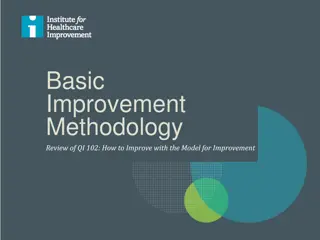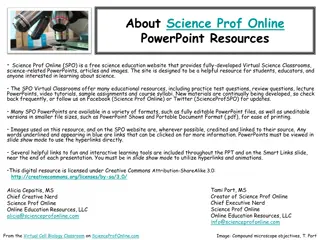
Quality Improvement Methods: Origins, Examples, and Pioneers
Explore the origins of quality improvement methods, examples like LEAN and Six Sigma, and pioneers in quality such as Deming and Juran. Understand the scientific approach and knowledge required for successful quality improvement practices in various sectors, including healthcare.
Download Presentation

Please find below an Image/Link to download the presentation.
The content on the website is provided AS IS for your information and personal use only. It may not be sold, licensed, or shared on other websites without obtaining consent from the author. If you encounter any issues during the download, it is possible that the publisher has removed the file from their server.
You are allowed to download the files provided on this website for personal or commercial use, subject to the condition that they are used lawfully. All files are the property of their respective owners.
The content on the website is provided AS IS for your information and personal use only. It may not be sold, licensed, or shared on other websites without obtaining consent from the author.
E N D
Presentation Transcript
Origins of QI methods Most of today s quality improvement methods were developed in industry and have been adapted for use in other sectors, such as health. These industrial approaches have been used within healthcare for the past 30 years. The Health Foundation 2013, p.16
Examples of QI methods The Model for Improvement LEAN LEAN Six Sigma Microsystems. PDSA Theory of constraints All have their roots in industry and consist of rapid cycle testing in practice, studying variation and change ideas.
Pioneers of quality QI Methods are based on theories developed by pioneers of quality in the automobile industry such as: Edward Deming, -Foundations of science for improvement/14 point for quality management Joseph Juran, Quality Planning, Quality Control and Quality Improvement Walter Shewhart. Studying Variation
Demings 14 points of management Create constancy of purpose for improving products and services. Adopt the new philosophy. Cease dependence on inspection to achieve quality. End the practice of awarding business on price alone; instead, minimize total cost by working with a single supplier. Improve constantly and forever every process for planning, production and service. Institute training on the job. Adopt and institute leadership. Drive out fear. Break down barriers between staff areas. Eliminate slogans, exhortations and targets for the workforce. Eliminate numerical quotas for the workforce and numerical goals for management. Remove barriers that rob people of pride of workmanship, and eliminate the annual rating or merit system. Institute a vigorous program of education and self-improvement for everyone. Put everybody in the company to work accomplishing the transformation.
What is required for Quality Improvement Use a Use a Scientific approach to Improvement Scientific approach to Improvement 1. Foundation of the Science of Improvement (Deming) 2. The Science of Quality Improvement/ Model for Improvement ( IHI) 3. Framework for Improving Quality in Our Health Service. Quality in Our Health Service. (IHI 2009)
Science of Improvement Appreciation of the system Understanding variation Theory of knowledge Knowledge of psychology Subject Matter expertise
Science of Improvement Science of Improvement- - Knowledge for Improvement 2 Kinds of knowledge vital for developing changes that result in improvement (Edward Deming) 1. Subject Matter Expertise -Healthcare staff acquire knowledge/learning both formal and informal which is reinforced through experiences 2. System of Profound knowledge- deep insight this knowledge offers into how to make changes that will result in improvement. Theory or knowledge of 1. Systems 2. Variation 3. Knowledge 4. Psychology Deming s system of profound Knowledge (as cited in Langley G et al. 2009,p.75).
Subject Matter Expertise Healthcare staff acquire knowledge/learning both formal and informal which is reinforced through experiences. give work back to people, to define and solve problems believing that people working closest to the system can often be in the best position to identify and solve problems . Ronald Heifetz as citied by Hilton and Anderson (2018, p.5)
Demings system of profound knowledge System of Profound knowledge- Profound refers to deep insight that this knowledge offers into how to make changes that will result in improvement. Theory or knowledge of : 1. 2. 3. 4. Systems Variation Knowledge Psychology The four parts all interrelate QI Leaders need to understand the basic theories behind all four
Appreciation of the system A system is an interdependent group of items, people, or processes working together towards a common purpose. Common purpose aligns the parts of the system Interdependence considers the relationships and interactions between them Organisations are made up of: Department People Equipment Facilities Functions No matter how well each part of the system functions if they don t operate well together- maximise their effectiveness then the system as a whole will not work as well as it should(Langley et al 2009)
Appreciation of the system contd., Consideration needs to be given to the following: interdependence within the system, i.e. Processes boundaries of a system, impact of previous solutions on current problems, constraints or bottlenecks within the system and acknowledging the central law of improvement; which means that: every system is perfectly designed to deliver the results it produces Langley G et al. 2009, p.78.
Understanding Variation Understanding Variation Walter Shewhart was one of the pioneers in developing the theory to understand variation. To begin to measure variation, one must firstly plot data over a period of time. Through analysing the trends in the data, patterns can be observed. The data is either predictable or unpredictable. Statistical theory can be used to develop a means to differentiate between both. Langley G et al. (2009, p.75)
Types of variation Types of variation- - Common cause Common cause Common cause variation: 1. Causes are inherent in the process overtime, they affect everyone working in the process and all outcomes of the process. 2. This is known as a stable process in statistical terms in that it implies that the variation only is predictable. 3. In practice it means that improvement can be achieved only by fundamental change to the process. (Langley G et al. 2009, p.80).
Types of variation Types of variation- - Special cause Special cause Special cause variation: 1. Causes are not part of the process or system all the time; 2. They do not affect everyone but arise because of specific circumstances, 3. The variation from one period to the next is unpredictable. (Langley G et al. 2009, p.80).
Statistical analysis A process whose outcomes are affected by both common and special causes is called an unstable process If the special causes for variation can be identified and addressed then the system becomes statistically stable, from here changes can be identified and implemented to improve performance. Shewhart developed the control chart method to determine whether variation in a system is dominated by common or special causes (Langley G et al. 2009 p.81).
Statistical thinking Statistical thinking is based on the following fundamental principles: All work occurs in a system of interconnected processes. Variation exists in all processes. Understanding and reducing variation are keys to success . Snee (2008)
The Human side of change Deming in his system of profound knowledge acknowledged the importance of the human side of change stating that all change occurs in human systems, in which people interact with each other(Langley G et al. 2009, p.83). For improvement to succeed, leaders need to understand and master the broad area of psychology and interpersonal relationships and acknowledge that people are a fundamental source of value regardless of their identity or position and it takes work and expertise to create a culture that respects and motivates them to meaningfully contribute to the solution. Hilton and Anderson (2018, p. 5)
Building Knowledge The greater the knowledge of the system and how it functions, the better the prediction and the greater likelihood the change will result in improvement (Langley G et al. (2009, p.81) Theory of Knowledge refers to the development of practical knowledge of what works. It is grounded in predictions about the results to be achieved through system changes. Knowledge is gained through a process of stating a theory, making a prediction based on the theory, comparing observations with predictions, and revising or abandoning the theory accordingly. The explicit goal of the science of improvement is to increase such knowledge (Scoville and Little (2014, p.12)
Building Knowledge contd., Skilfully building knowledge by making changes and observing or measuring results is the foundation of improvement. Langley G et al. (2009, p.82) Repeating learning cycles, the theory becomes useful for predictions in future circumstances. The Plan, Do, Study, Act (PDSA) cycle which is part of the model for improvements approach to change supports repeated learning from tests of change carried out in practice.






















